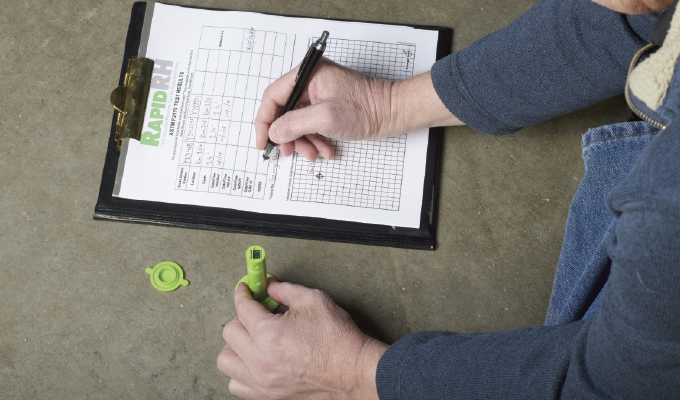What people are saying about their experiences
By Jason Spangler
Everyone knows: There’s the manual—and then there’s the real world.
For the last year or so, those of us who measure moisture in concrete floor slabs have been excited that the ASTM F2170 standard now allows official documentation of in situ relative humidity (RH) test results after just 24 hours, instead of 72 hours. Who doesn’t want to cut 2 full days out of their project timeline?
This also sparked a thought that while flooring inspectors, installers, and general contractors are charged with following the standard when doing RH testing, real life isn’t always entirely cut and dry (no pun intended). We thought now would be a good time to hear from people on the ground. What are your experiences measuring concrete moisture? To find out, we posted this question on LinkedIn:
When doing concrete moisture testing in the real world, what difficulties have you had or what issues have you seen that impacted getting accurate results? What lessons have you gleaned from these experiences?
We went through all the responses (thanks so much to everyone who joined the conversation) and found a few themes. Here are several tips from your peers about how to put theory into practice.
YOU CAN’T JUST FOLLOW THE INSTRUCTIONS
This one surprised us a bit. In situ RH testing is not rocket science. And yet, people cited poor training or execution as a key issue. One aspect of this is making sure that testing is done consistently and correctly every time. For example, always making sure the right number of RH probes are placed in the concrete for the square footage being tested.
However, the issue really went deeper than this. Some people described their challenge in finding people who have the right training to perform RH testing so they have the assurance of getting accurate, reliable results.
David P. says this: “Getting the right personnel to perform the testing might be perhaps the biggest challenge I see. Very few individuals are properly trained (certified notwithstanding) to know what they are doing. Certification does not underscore competency.”
Again, this is not to say RH testing is difficult. It is not. The methodology is easy enough that anybody can do it. But at the same time, there are important things to know to do it right. This is why Wagner Meters, for instance, offers a free one-hour moisture testing webinar and live Q&A twice monthly for all its customers.
LOOK AT THE WORLD AROUND YOU, AND BE SURE TO CHECK UNDER THE HOOD
People responded about how important it is to pay attention to the ambient conditions where the testing is happening. ASTM F2170 requires conducting the test at service conditions. This refers to the ambient conditions that people will experience inside the building once it is placed into service. Testing at anything other than service conditions will mess with your results. The jobsite must be given time to acclimate per ASTM F2170.
Another key issue people raised was making sure the hole is not dusty and there’s no silica in the air to skew readings.
A number of people mentioned that even if the slab is on grade, they don’t always know the substrate conditions or if a vapor retarder was ever installed under the slab. Making matters more challenging, it can sometimes be difficult to find out. Making matters even worse, there’s not a whole lot you can do about it if a vapor retarder was not installed.
One poster named JD sums it this way: “Testing any concrete that has questionable substrate conditions is of limited use. I am called far too often to confirm the concrete is suitable for a moisture-sensitive coating only to find that nobody has ever even looked for a proper under-slab moisture retarder. Sure, I can tell you what the slab RH is at now, but it is probably open to absorbing unlimited amounts of moisture from the soil it sits on.”
KNOW THE LIMITS OF YOUR TEST
ASTM F2170 requires the use of RH sensors that are calibrated within +/- 2 percent between 50 to 90 percent RH, which begs the question: How accurate is accurate?
This 2 percent factor should not be glossed over. One poster named JD gave an example where the test result showed the slab at 94 percent RH and within the specification for an adhesive that’s rated to sustain up to 95 percent RH. Does this guarantee the flooring installation won’t fail because it meets the specification? Will this result protect you in court if there is a flooring failure?
He went on to suggest, “Products manufactured to withstand a certain level of moisture or alkalinity must have a fudge factor built into their specification to encompass variables in testing. If they do not, the manufacturer [may well be] in a position of legal liability for failures.”
The fingers will start pointing in all directions if a flooring failure occurs, but what more can anyone do but be diligent in following the standard and properly executing the RH test.
CLOSING THOUGHT
In spite of the above considerations encountered in the real world, the risk of failure can be minimized by taking the right action. And, the RH test has a scientific pedigree that no other industry-accepted method for testing concrete moisture can offer. Its proven reliability and ease of use are why the RH test has rapidly grown to become the No. 1 moisture test for assessing the readiness of concrete slabs for flooring installations.
About the author
Jason Spangler, Wagner Meters’ flooring division manager, has more than 25 years’ experience in sales and sales management across a broad spectrum of industries. He has successfully launched a variety of products to the market, including the original Rapid RHˇ concrete moisture test. For more, visit www.wagnermeters.com.
Modern Contractor Solutions, September 2019
Did you enjoy this article?
Subscribe to the FREE Digital Edition of Modern Contractor Solutions magazine.



